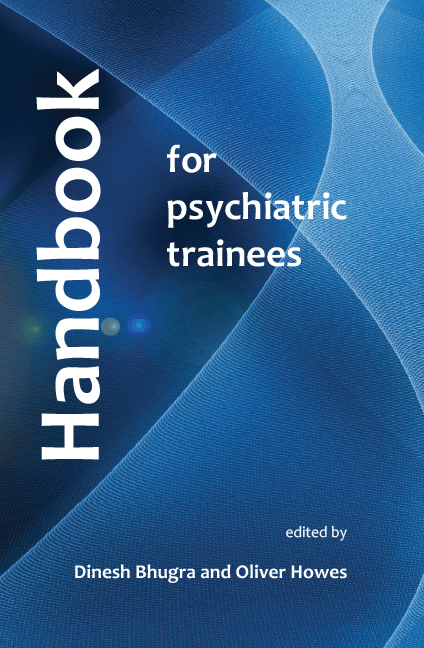Book contents
- Frontmatter
- Contents
- List of tables, boxes and figures
- List of contributors
- 1 Psychiatric training: the next steps
- Part 1
- Part 2
- Part 3
- 14 Personal safety
- 15 Managing violence
- 16 Managing difficult clinical situations
- 17 Understanding and managing stress
- 18 Managing time: the key to professional success
- 19 Negotiation skills
- 20 Presentation skills
- 21 Mental health review tribunals: reports and hearings
- 22 How to get published
- 23 Mental health informatics
- 24 Clinical governance
- 25 Lifelong learning and revalidation
- 26 Mentoring and shadowing
- 27 The MRCPsych examinations
- 28 Flexible training
- 29 UK training for overseas doctors and opportunities for UK doctors to train outside the EEC
- 30 Academic careers
- 31 Higher degrees
- Index
14 - Personal safety
from Part 3
- Frontmatter
- Contents
- List of tables, boxes and figures
- List of contributors
- 1 Psychiatric training: the next steps
- Part 1
- Part 2
- Part 3
- 14 Personal safety
- 15 Managing violence
- 16 Managing difficult clinical situations
- 17 Understanding and managing stress
- 18 Managing time: the key to professional success
- 19 Negotiation skills
- 20 Presentation skills
- 21 Mental health review tribunals: reports and hearings
- 22 How to get published
- 23 Mental health informatics
- 24 Clinical governance
- 25 Lifelong learning and revalidation
- 26 Mentoring and shadowing
- 27 The MRCPsych examinations
- 28 Flexible training
- 29 UK training for overseas doctors and opportunities for UK doctors to train outside the EEC
- 30 Academic careers
- 31 Higher degrees
- Index
Summary
It cannot be stated strongly enough that if you are ever in a situation that feels unsafe you should (a) try and exit that situation as rapidly as possible and/or (b) summon assistance as quickly as you can. Never put yourself in harm'sway if this can be avoided.
When considering personal safety as a psychiatric trainee there are a series of factors that should be considered but which cluster around three main areas. These are: patient factors, environmental/situational factors and team/training factors.
Patient factors
These factors, which increase the risk of violence, will also be part of your risk assessment. They should, however, always be considered when approaching any patient and can be represented as questions for which you would like an answer, from an informant, relevant staff or the patient'snotes.
Does this patient have a previous history of violence?
A previous history of violent acts is the best predictor of future violent acts. Generally speaking, the more serious the intent of the previous act and the less the remorse or understanding of the act, the greater the future risk. With time from last violent episode the risk is attenuated, but remains the only robust predictor of violence.
What is the patient'sage and gender?
In general younger people tend to be more likely to commit violent acts than older people and males are more likely to be violent than females. It must be remembered, however, that even the elderly and females can be very violent, and other predictors are probably more important in judging the risk to personal safety.
Has there been a stated threat of violence?
People who are threatening violence will often act on their threats if their demands are not met. There is a popular misconception that threats of violence are in some way ‘bluster’, ‘attention-seeking’ or the patient ‘working out their anger’; such threats are a clear warning, should be taken seriously and attempts should be made to explore them with the patient.
Does the patient have an association with a subculture prone to violence?
These subcultures sometimes involve street gangs or other violent subcultures with which the patient identifies. Again, the risk of violence is increased as the patient is more likely to express themselves through violence rather than verbally.
- Type
- Chapter
- Information
- Handbook for Psychiatric Trainees , pp. 129 - 135Publisher: Royal College of PsychiatristsPrint publication year: 2008



